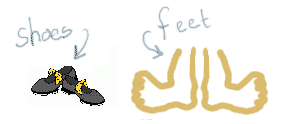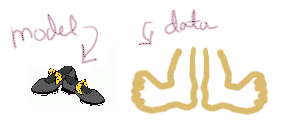What's your threshold for pain?
 If your shoes don't fit a little, they might cause a little pain, but not enough to pay attention to.
But somewhere there's a threshold. If the shoe is too small, you go out and buy new ones.
If your shoes don't fit a little, they might cause a little pain, but not enough to pay attention to.
But somewhere there's a threshold. If the shoe is too small, you go out and buy new ones.
 In the same way, saying that something is only 30% likely to occur according to the null hypothesis,
is not enough pain to say that the data does not fit the model. But there is a threshold, called a
p-value (p stands for "probability", not "pain"). In fact, most scientists use
a 5% threshold.
In the same way, saying that something is only 30% likely to occur according to the null hypothesis,
is not enough pain to say that the data does not fit the model. But there is a threshold, called a
p-value (p stands for "probability", not "pain"). In fact, most scientists use
a 5% threshold.
Usually when we talk about p-values, we're in the middle of doing some sort of statistics (like a t-test, a regression, or a chi-square test). But p-values work just as well for the brute-force simulation we're discussing here. The idea is, if the hypothesized process (in this case, random sickdays) produces the observed data less than 5% of the time, then the hypothesized process is probably NOT responsible for the data.
How could the 5% threshold be applied to the sickdays problems?
(To make this problem interactive, turn on javascript!)
- I need a hint ... : 5% would mean 5 out of 100 trials...
- ...another hint ... : If NO MORE THAN 5% of trials had 42 or more sickdays, what would that mean?
I think I have the answer: If NO MORE THAN 5% of trials had 42
or more mon/fri sickdays, that would mean that having 42 mon/fri
sickdays was rare -- too rare to occur by our null hypothesis
of random sick days. It would support the bosses' hypothesis.
This-is-not-a-stupid-question question:
If you were following that closely, you realize that in order to show that the data fits the model, you need to show that the hypothesized process produces the observed data MORE THAN 5% of the time. On the other hand, if you are familiar with t-tests or regression, you know that a "good" result is one in which your value is LESS THAN the p-value.
The reason for this discrepancy is that with a t-test you are trying to DISPROVE the null hypothesis. In a goodness of fit test, you are trying to SUPPORT the null hypothesis. So:
| t-test | goal: disprove the null hypothesis | want to go below the p-value |
| chi-square | goal: show that the data fits the null hypothesis | want to exceed the p-value |
Copyright University of Maryland, 2007
You may link to this site for educational purposes.
Please do not copy without permission
requests/questions/feedback email: mathbench@umd.edu